1994 JEEP CHEROKEE service
[x] Cancel search: servicePage 1485 of 1784
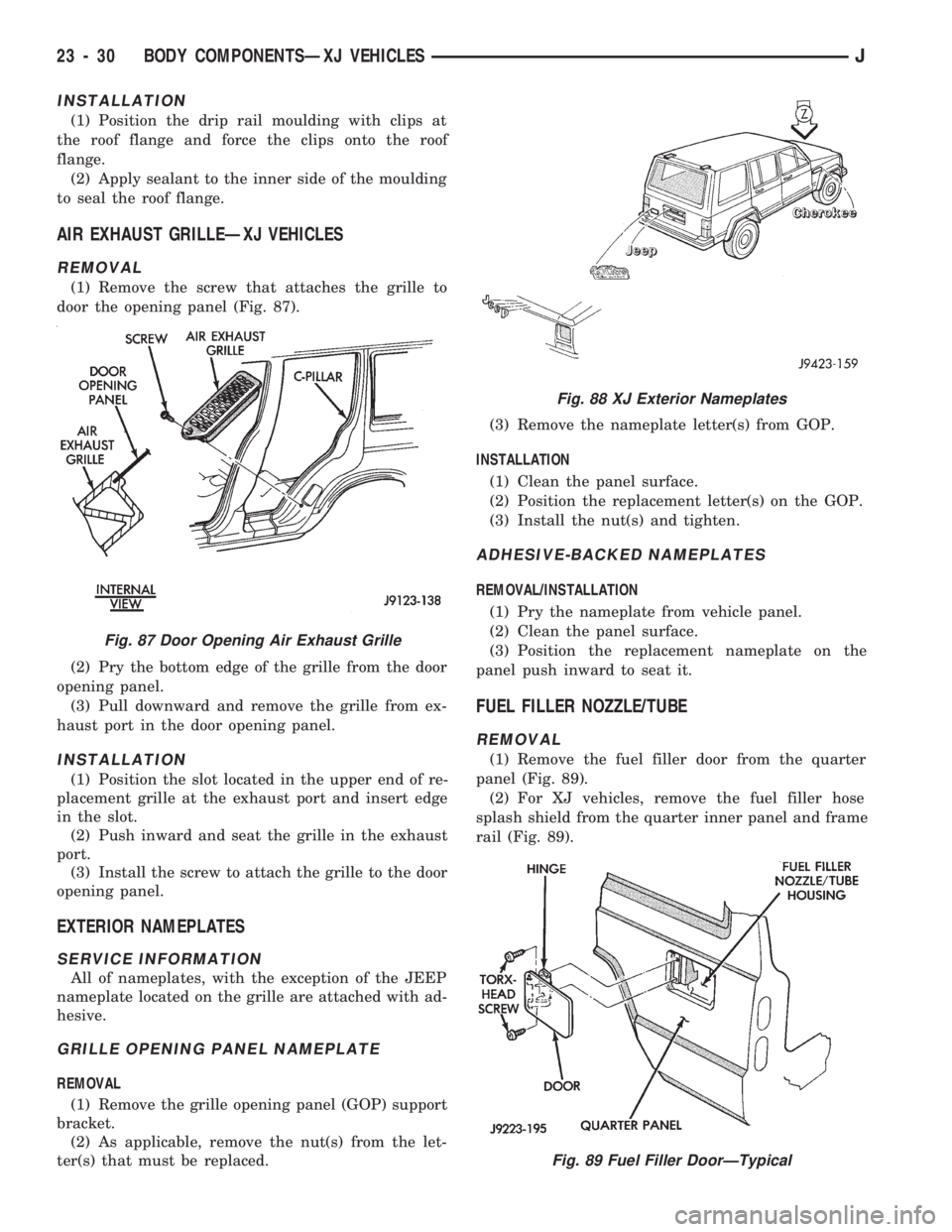
INSTALLATION
(1) Position the drip rail moulding with clips at
the roof flange and force the clips onto the roof
flange.
(2) Apply sealant to the inner side of the moulding
to seal the roof flange.
AIR EXHAUST GRILLEÐXJ VEHICLES
REMOVAL
(1) Remove the screw that attaches the grille to
door the opening panel (Fig. 87).
(2) Pry the bottom edge of the grille from the door
opening panel.
(3) Pull downward and remove the grille from ex-
haust port in the door opening panel.
INSTALLATION
(1) Position the slot located in the upper end of re-
placement grille at the exhaust port and insert edge
in the slot.
(2) Push inward and seat the grille in the exhaust
port.
(3) Install the screw to attach the grille to the door
opening panel.
EXTERIOR NAMEPLATES
SERVICE INFORMATION
All of nameplates, with the exception of the JEEP
nameplate located on the grille are attached with ad-
hesive.
GRILLE OPENING PANEL NAMEPLATE
REMOVAL
(1) Remove the grille opening panel (GOP) support
bracket.
(2) As applicable, remove the nut(s) from the let-
ter(s) that must be replaced.(3) Remove the nameplate letter(s) from GOP.
INSTALLATION
(1) Clean the panel surface.
(2) Position the replacement letter(s) on the GOP.
(3) Install the nut(s) and tighten.
ADHESIVE-BACKED NAMEPLATES
REMOVAL/INSTALLATION
(1) Pry the nameplate from vehicle panel.
(2) Clean the panel surface.
(3) Position the replacement nameplate on the
panel push inward to seat it.
FUEL FILLER NOZZLE/TUBE
REMOVAL
(1) Remove the fuel filler door from the quarter
panel (Fig. 89).
(2) For XJ vehicles, remove the fuel filler hose
splash shield from the quarter inner panel and frame
rail (Fig. 89).
Fig. 89 Fuel Filler DoorÐTypical
Fig. 87 Door Opening Air Exhaust Grille
Fig. 88 XJ Exterior Nameplates
23 - 30 BODY COMPONENTSÐXJ VEHICLESJ
Page 1486 of 1784
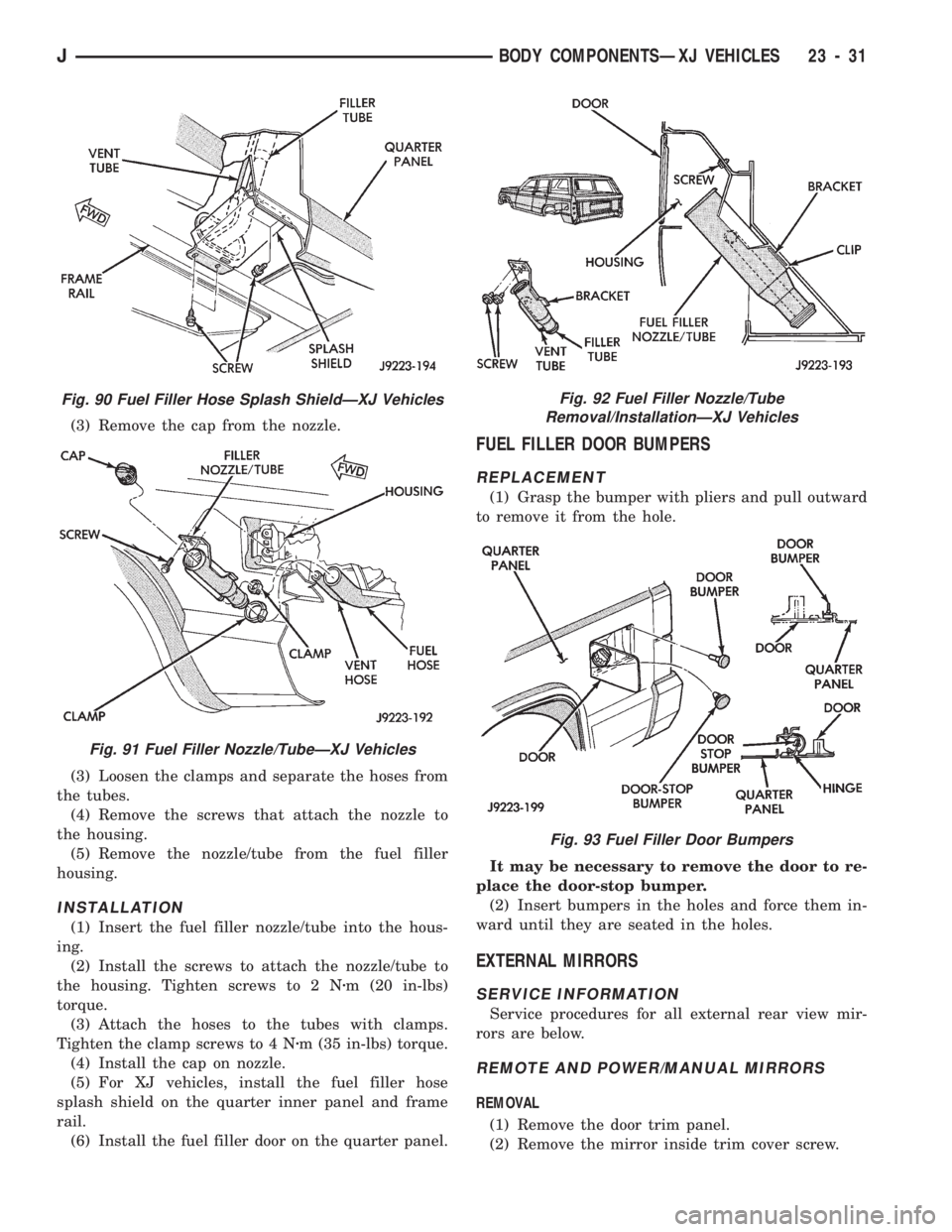
(3) Remove the cap from the nozzle.
(3) Loosen the clamps and separate the hoses from
the tubes.
(4) Remove the screws that attach the nozzle to
the housing.
(5) Remove the nozzle/tube from the fuel filler
housing.
INSTALLATION
(1) Insert the fuel filler nozzle/tube into the hous-
ing.
(2) Install the screws to attach the nozzle/tube to
the housing. Tighten screws to 2 Nzm (20 in-lbs)
torque.
(3) Attach the hoses to the tubes with clamps.
Tighten the clamp screws to 4 Nzm (35 in-lbs) torque.
(4) Install the cap on nozzle.
(5) For XJ vehicles, install the fuel filler hose
splash shield on the quarter inner panel and frame
rail.
(6) Install the fuel filler door on the quarter panel.
FUEL FILLER DOOR BUMPERS
REPLACEMENT
(1) Grasp the bumper with pliers and pull outward
to remove it from the hole.
It may be necessary to remove the door to re-
place the door-stop bumper.
(2) Insert bumpers in the holes and force them in-
ward until they are seated in the holes.
EXTERNAL MIRRORS
SERVICE INFORMATION
Service procedures for all external rear view mir-
rors are below.
REMOTE AND POWER/MANUAL MIRRORS
REMOVAL
(1) Remove the door trim panel.
(2) Remove the mirror inside trim cover screw.
Fig. 90 Fuel Filler Hose Splash ShieldÐXJ Vehicles
Fig. 91 Fuel Filler Nozzle/TubeÐXJ Vehicles
Fig. 92 Fuel Filler Nozzle/Tube
Removal/InstallationÐXJ Vehicles
Fig. 93 Fuel Filler Door Bumpers
JBODY COMPONENTSÐXJ VEHICLES 23 - 31
Page 1489 of 1784
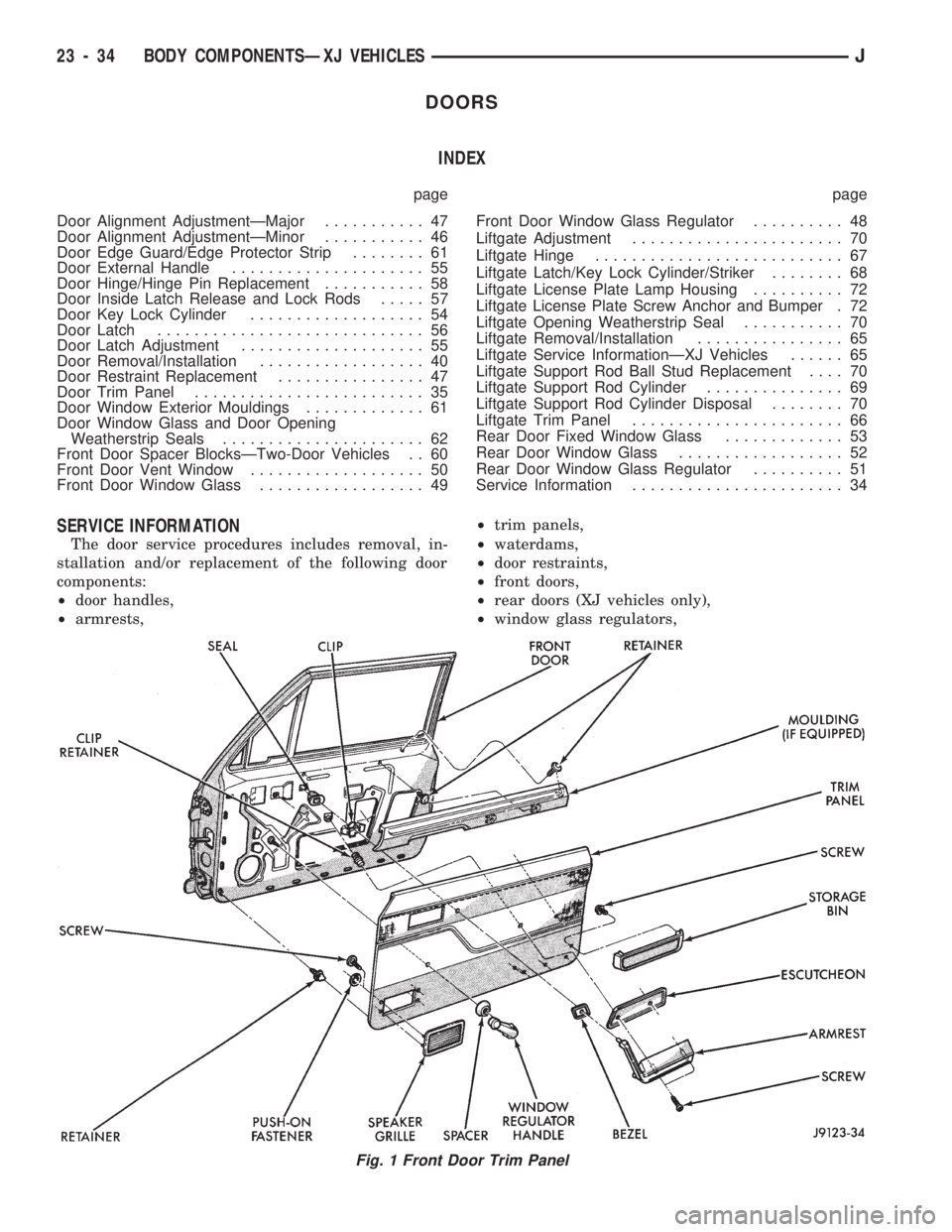
DOORS
INDEX
page page
Door Alignment AdjustmentÐMajor........... 47
Door Alignment AdjustmentÐMinor........... 46
Door Edge Guard/Edge Protector Strip........ 61
Door External Handle..................... 55
Door Hinge/Hinge Pin Replacement........... 58
Door Inside Latch Release and Lock Rods..... 57
Door Key Lock Cylinder................... 54
Door Latch............................. 56
Door Latch Adjustment.................... 55
Door Removal/Installation.................. 40
Door Restraint Replacement................ 47
Door Trim Panel......................... 35
Door Window Exterior Mouldings............. 61
Door Window Glass and Door Opening
Weatherstrip Seals...................... 62
Front Door Spacer BlocksÐTwo-Door Vehicles . . 60
Front Door Vent Window................... 50
Front Door Window Glass.................. 49Front Door Window Glass Regulator.......... 48
Liftgate Adjustment....................... 70
Liftgate Hinge........................... 67
Liftgate Latch/Key Lock Cylinder/Striker........ 68
Liftgate License Plate Lamp Housing.......... 72
Liftgate License Plate Screw Anchor and Bumper . 72
Liftgate Opening Weatherstrip Seal........... 70
Liftgate Removal/Installation................ 65
Liftgate Service InformationÐXJ Vehicles...... 65
Liftgate Support Rod Ball Stud Replacement.... 70
Liftgate Support Rod Cylinder............... 69
Liftgate Support Rod Cylinder Disposal........ 70
Liftgate Trim Panel....................... 66
Rear Door Fixed Window Glass............. 53
Rear Door Window Glass.................. 52
Rear Door Window Glass Regulator.......... 51
Service Information....................... 34
SERVICE INFORMATION
The door service procedures includes removal, in-
stallation and/or replacement of the following door
components:
²door handles,
²armrests,²trim panels,
²waterdams,
²door restraints,
²front doors,
²rear doors (XJ vehicles only),
²window glass regulators,
Fig. 1 Front Door Trim Panel
23 - 34 BODY COMPONENTSÐXJ VEHICLESJ
Page 1490 of 1784
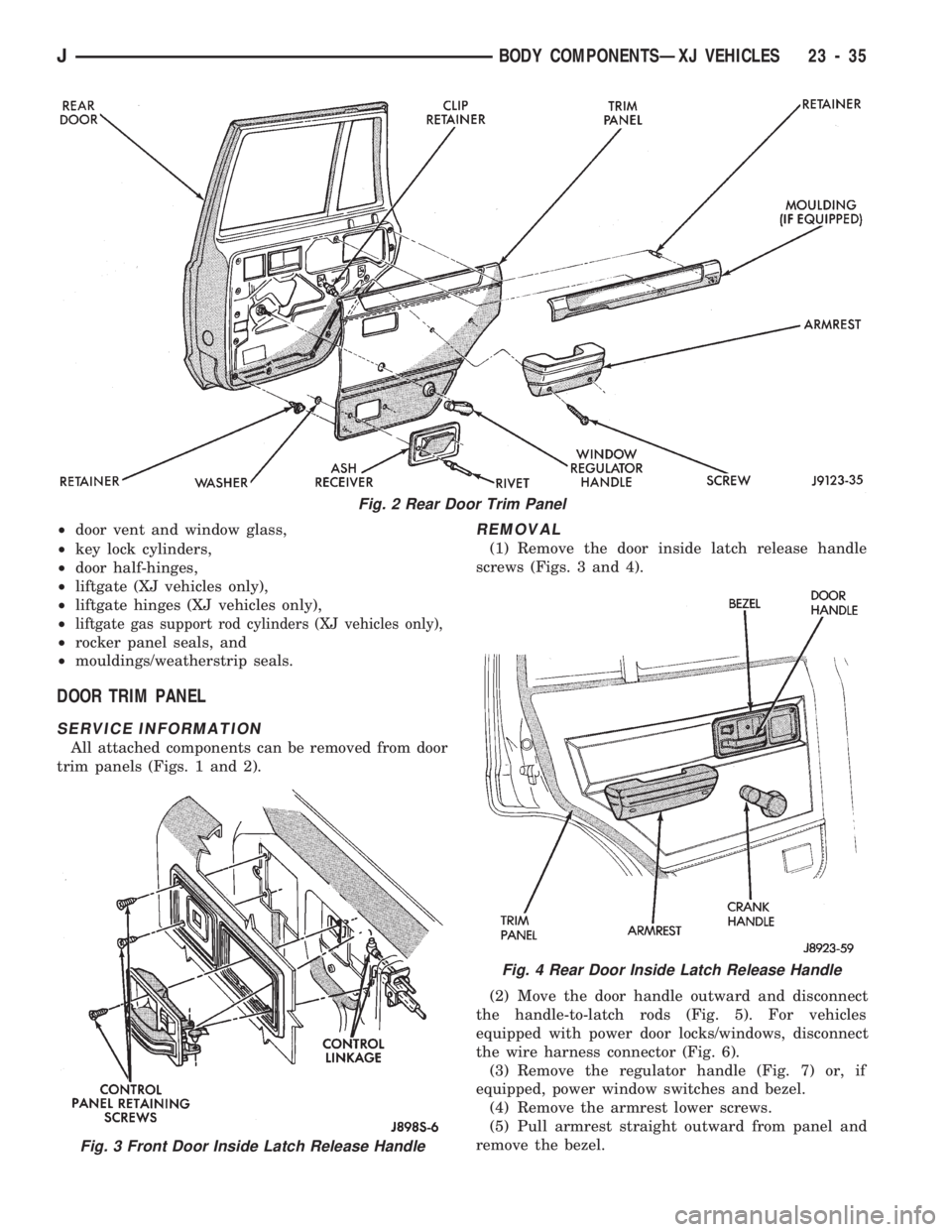
²door vent and window glass,
²key lock cylinders,
²door half-hinges,
²liftgate (XJ vehicles only),
²liftgate hinges (XJ vehicles only),
²
liftgate gas support rod cylinders (XJ vehicles only),
²rocker panel seals, and
²mouldings/weatherstrip seals.
DOOR TRIM PANEL
SERVICE INFORMATION
All attached components can be removed from door
trim panels (Figs. 1 and 2).
REMOVAL
(1) Remove the door inside latch release handle
screws (Figs. 3 and 4).
(2) Move the door handle outward and disconnect
the handle-to-latch rods (Fig. 5). For vehicles
equipped with power door locks/windows, disconnect
the wire harness connector (Fig. 6).
(3) Remove the regulator handle (Fig. 7) or, if
equipped, power window switches and bezel.
(4) Remove the armrest lower screws.
(5) Pull armrest straight outward from panel and
remove the bezel.
Fig. 2 Rear Door Trim Panel
Fig. 3 Front Door Inside Latch Release Handle
Fig. 4 Rear Door Inside Latch Release Handle
JBODY COMPONENTSÐXJ VEHICLES 23 - 35
Page 1520 of 1784
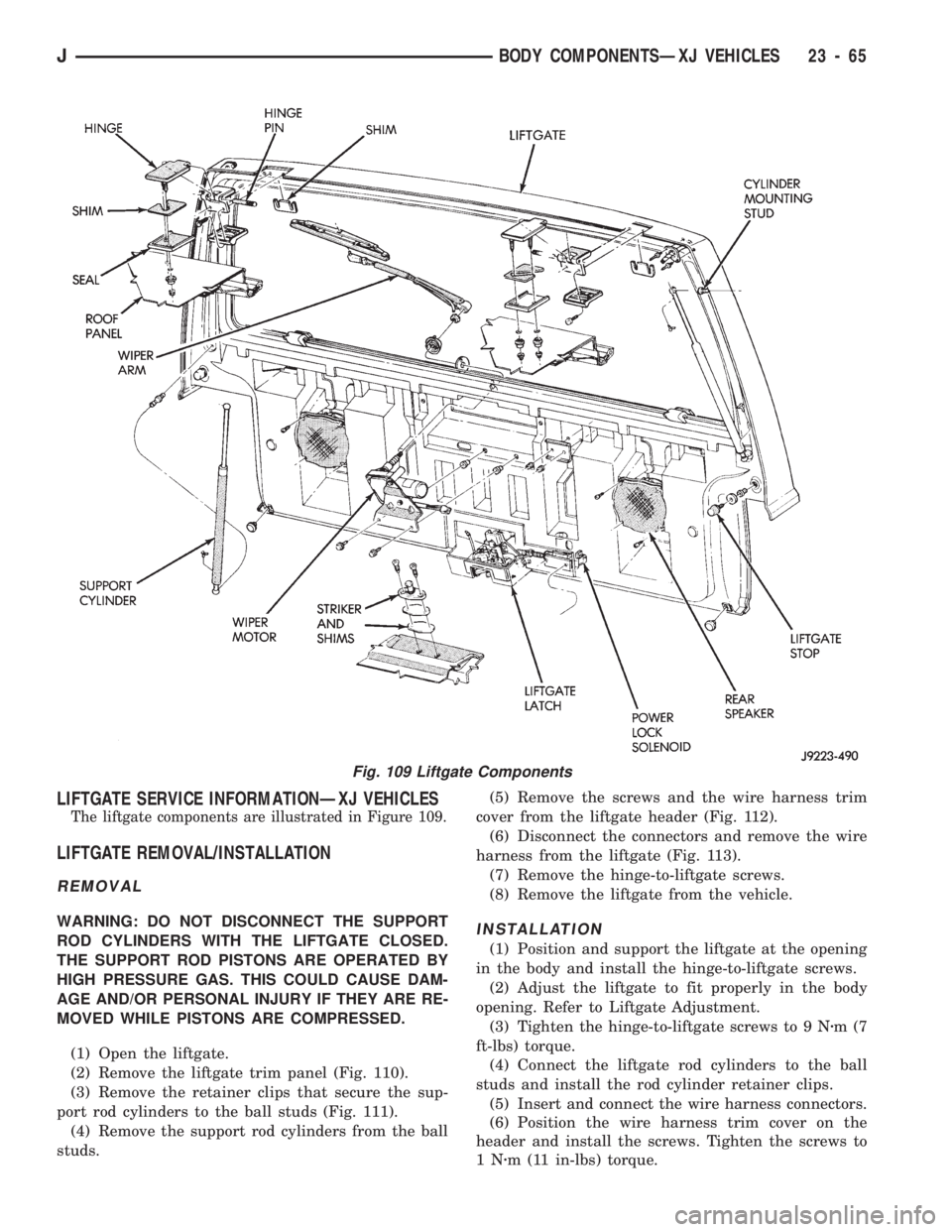
LIFTGATE SERVICE INFORMATIONÐXJ VEHICLES
The liftgate components are illustrated in Figure 109.
LIFTGATE REMOVAL/INSTALLATION
REMOVAL
WARNING: DO NOT DISCONNECT THE SUPPORT
ROD CYLINDERS WITH THE LIFTGATE CLOSED.
THE SUPPORT ROD PISTONS ARE OPERATED BY
HIGH PRESSURE GAS. THIS COULD CAUSE DAM-
AGE AND/OR PERSONAL INJURY IF THEY ARE RE-
MOVED WHILE PISTONS ARE COMPRESSED.
(1) Open the liftgate.
(2) Remove the liftgate trim panel (Fig. 110).
(3) Remove the retainer clips that secure the sup-
port rod cylinders to the ball studs (Fig. 111).
(4) Remove the support rod cylinders from the ball
studs.(5) Remove the screws and the wire harness trim
cover from the liftgate header (Fig. 112).
(6) Disconnect the connectors and remove the wire
harness from the liftgate (Fig. 113).
(7) Remove the hinge-to-liftgate screws.
(8) Remove the liftgate from the vehicle.INSTALLATION
(1) Position and support the liftgate at the opening
in the body and install the hinge-to-liftgate screws.
(2) Adjust the liftgate to fit properly in the body
opening. Refer to Liftgate Adjustment.
(3) Tighten the hinge-to-liftgate screws to 9 Nzm(7
ft-lbs) torque.
(4) Connect the liftgate rod cylinders to the ball
studs and install the rod cylinder retainer clips.
(5) Insert and connect the wire harness connectors.
(6) Position the wire harness trim cover on the
header and install the screws. Tighten the screws to
1Nzm (11 in-lbs) torque.
Fig. 109 Liftgate Components
JBODY COMPONENTSÐXJ VEHICLES 23 - 65
Page 1525 of 1784
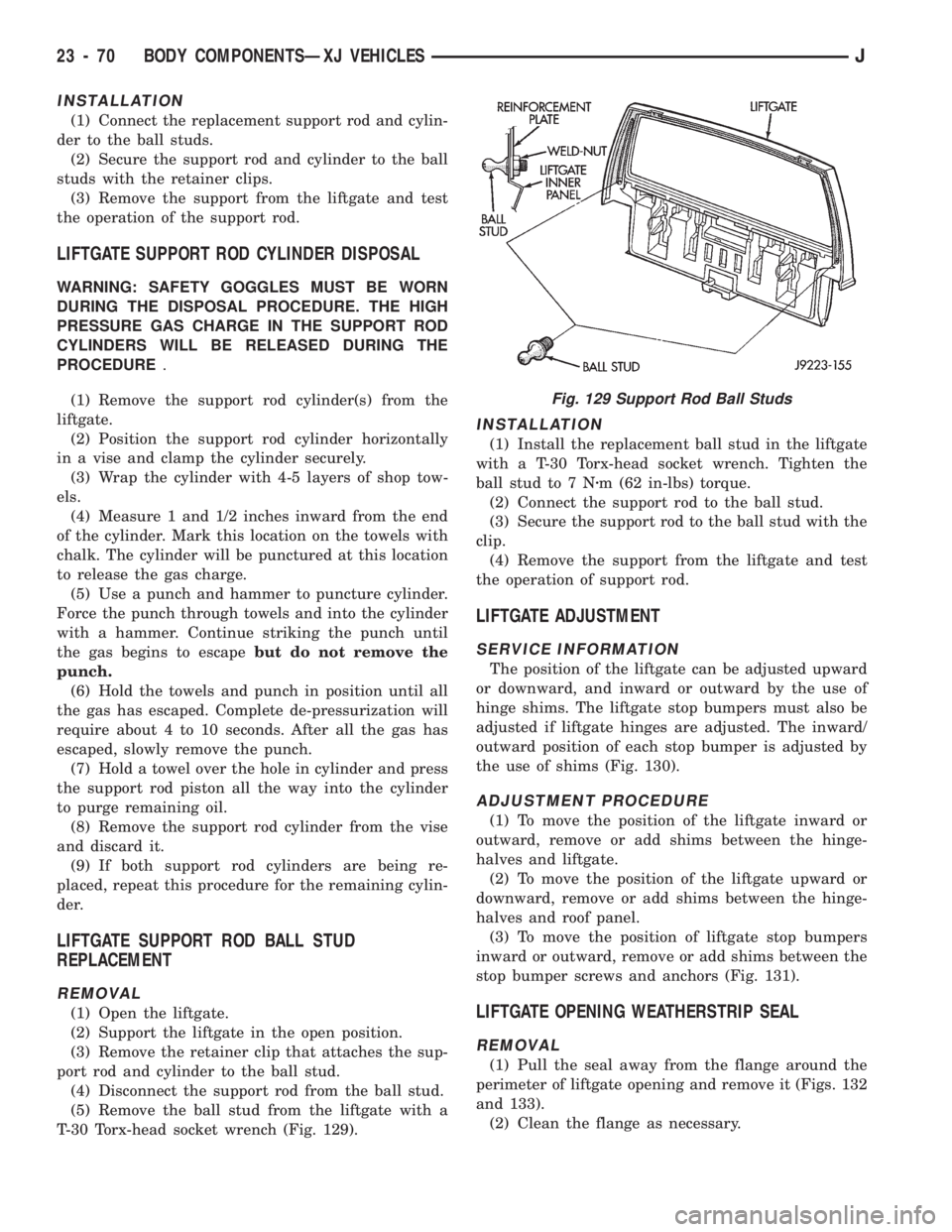
INSTALLATION
(1) Connect the replacement support rod and cylin-
der to the ball studs.
(2) Secure the support rod and cylinder to the ball
studs with the retainer clips.
(3) Remove the support from the liftgate and test
the operation of the support rod.
LIFTGATE SUPPORT ROD CYLINDER DISPOSAL
WARNING: SAFETY GOGGLES MUST BE WORN
DURING THE DISPOSAL PROCEDURE. THE HIGH
PRESSURE GAS CHARGE IN THE SUPPORT ROD
CYLINDERS WILL BE RELEASED DURING THE
PROCEDURE.
(1) Remove the support rod cylinder(s) from the
liftgate.
(2) Position the support rod cylinder horizontally
in a vise and clamp the cylinder securely.
(3) Wrap the cylinder with 4-5 layers of shop tow-
els.
(4) Measure 1 and 1/2 inches inward from the end
of the cylinder. Mark this location on the towels with
chalk. The cylinder will be punctured at this location
to release the gas charge.
(5) Use a punch and hammer to puncture cylinder.
Force the punch through towels and into the cylinder
with a hammer. Continue striking the punch until
the gas begins to escapebut do not remove the
punch.
(6) Hold the towels and punch in position until all
the gas has escaped. Complete de-pressurization will
require about 4 to 10 seconds. After all the gas has
escaped, slowly remove the punch.
(7) Hold a towel over the hole in cylinder and press
the support rod piston all the way into the cylinder
to purge remaining oil.
(8) Remove the support rod cylinder from the vise
and discard it.
(9) If both support rod cylinders are being re-
placed, repeat this procedure for the remaining cylin-
der.
LIFTGATE SUPPORT ROD BALL STUD
REPLACEMENT
REMOVAL
(1) Open the liftgate.
(2) Support the liftgate in the open position.
(3) Remove the retainer clip that attaches the sup-
port rod and cylinder to the ball stud.
(4) Disconnect the support rod from the ball stud.
(5) Remove the ball stud from the liftgate with a
T-30 Torx-head socket wrench (Fig. 129).
INSTALLATION
(1) Install the replacement ball stud in the liftgate
with a T-30 Torx-head socket wrench. Tighten the
ball stud to 7 Nzm (62 in-lbs) torque.
(2) Connect the support rod to the ball stud.
(3) Secure the support rod to the ball stud with the
clip.
(4) Remove the support from the liftgate and test
the operation of support rod.
LIFTGATE ADJUSTMENT
SERVICE INFORMATION
The position of the liftgate can be adjusted upward
or downward, and inward or outward by the use of
hinge shims. The liftgate stop bumpers must also be
adjusted if liftgate hinges are adjusted. The inward/
outward position of each stop bumper is adjusted by
the use of shims (Fig. 130).
ADJUSTMENT PROCEDURE
(1) To move the position of the liftgate inward or
outward, remove or add shims between the hinge-
halves and liftgate.
(2) To move the position of the liftgate upward or
downward, remove or add shims between the hinge-
halves and roof panel.
(3) To move the position of liftgate stop bumpers
inward or outward, remove or add shims between the
stop bumper screws and anchors (Fig. 131).
LIFTGATE OPENING WEATHERSTRIP SEAL
REMOVAL
(1) Pull the seal away from the flange around the
perimeter of liftgate opening and remove it (Figs. 132
and 133).
(2) Clean the flange as necessary.
Fig. 129 Support Rod Ball Studs
23 - 70 BODY COMPONENTSÐXJ VEHICLESJ
Page 1528 of 1784
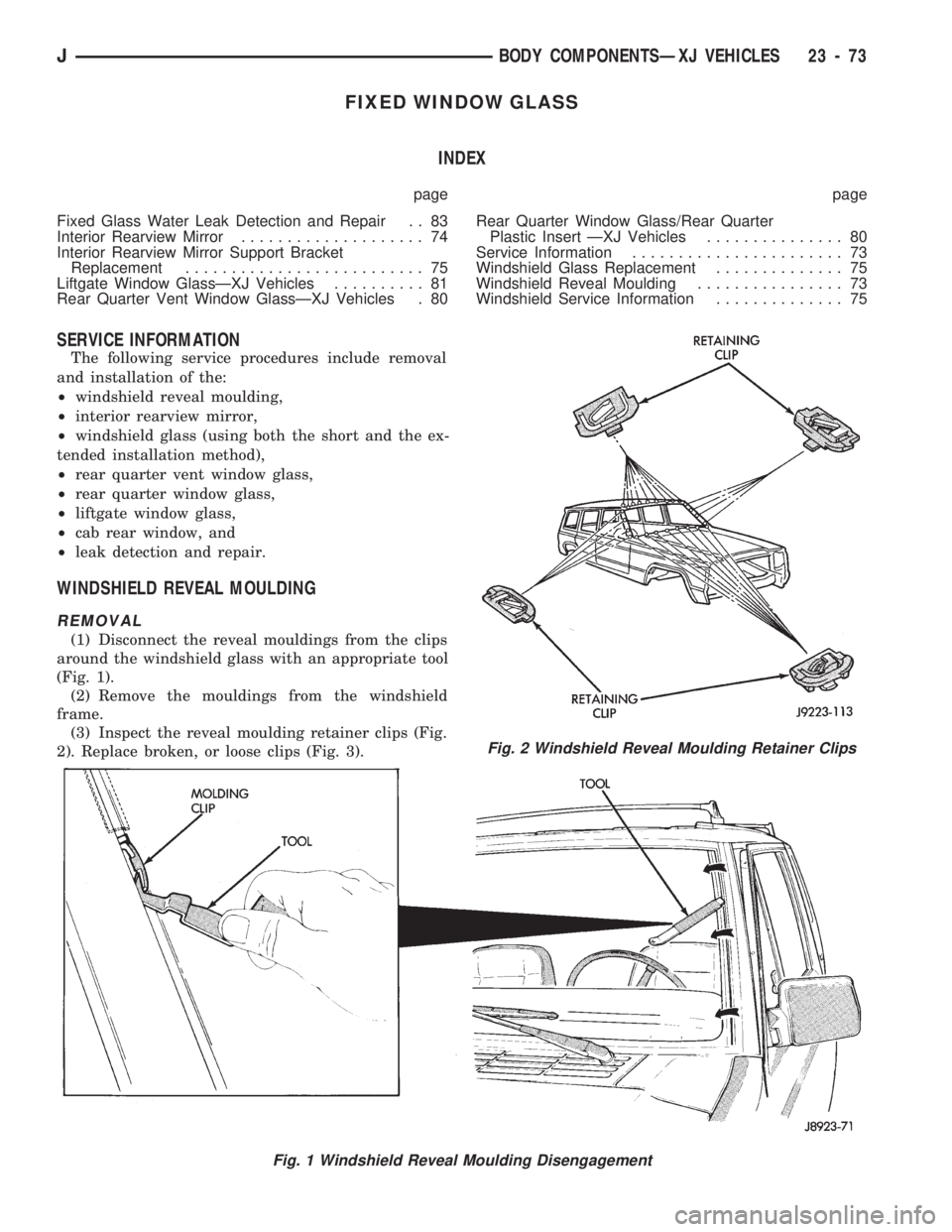
FIXED WINDOW GLASS
INDEX
page page
Fixed Glass Water Leak Detection and Repair . . 83
Interior Rearview Mirror.................... 74
Interior Rearview Mirror Support Bracket
Replacement.......................... 75
Liftgate Window GlassÐXJ Vehicles.......... 81
Rear Quarter Vent Window GlassÐXJ Vehicles . 80Rear Quarter Window Glass/Rear Quarter
Plastic Insert ÐXJ Vehicles............... 80
Service Information....................... 73
Windshield Glass Replacement.............. 75
Windshield Reveal Moulding................ 73
Windshield Service Information.............. 75
SERVICE INFORMATION
The following service procedures include removal
and installation of the:
²windshield reveal moulding,
²interior rearview mirror,
²windshield glass (using both the short and the ex-
tended installation method),
²rear quarter vent window glass,
²rear quarter window glass,
²liftgate window glass,
²cab rear window, and
²leak detection and repair.
WINDSHIELD REVEAL MOULDING
REMOVAL
(1) Disconnect the reveal mouldings from the clips
around the windshield glass with an appropriate tool
(Fig. 1).
(2) Remove the mouldings from the windshield
frame.
(3) Inspect the reveal moulding retainer clips (Fig.
2). Replace broken, or loose clips (Fig. 3).
Fig. 1 Windshield Reveal Moulding Disengagement
Fig. 2 Windshield Reveal Moulding Retainer Clips
JBODY COMPONENTSÐXJ VEHICLES 23 - 73
Page 1530 of 1784
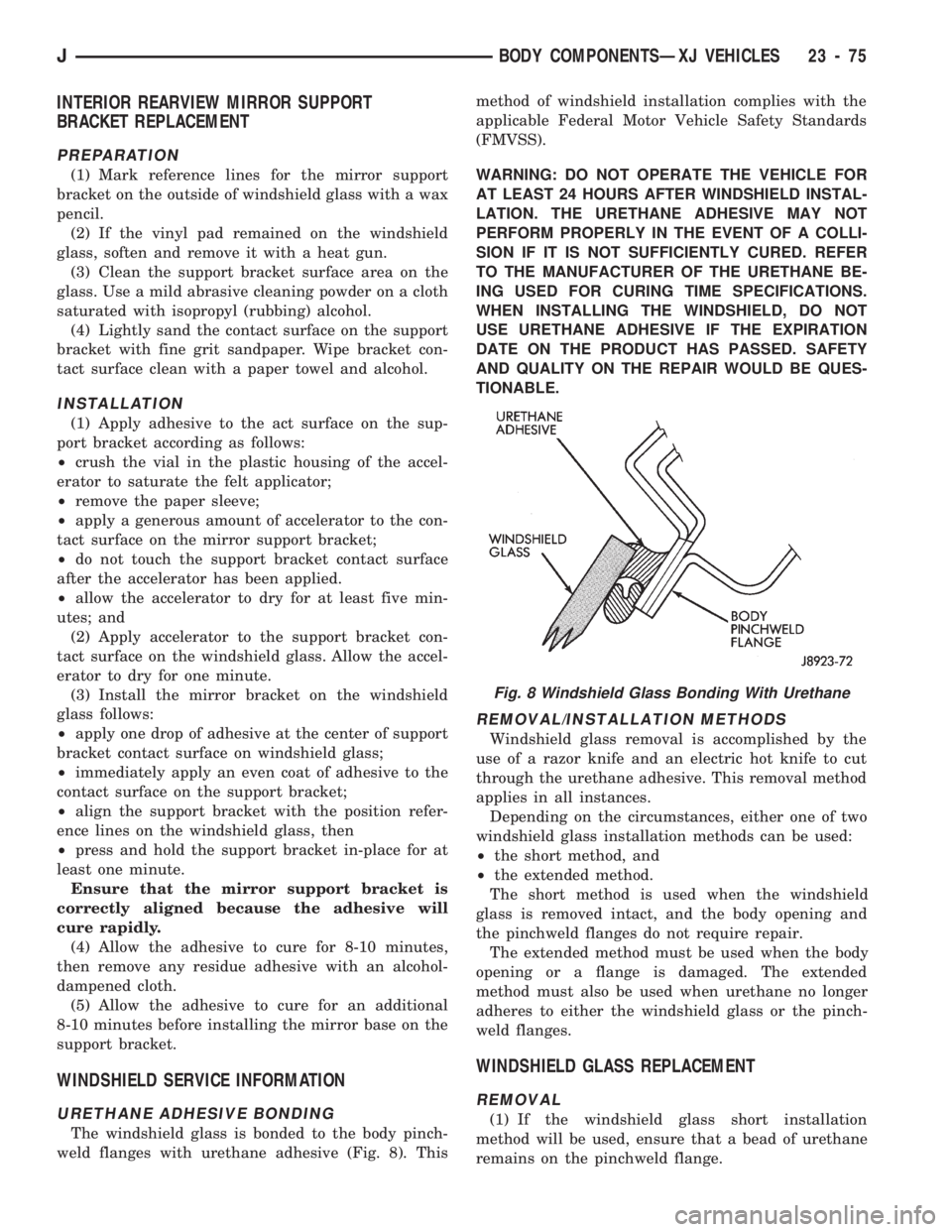
INTERIOR REARVIEW MIRROR SUPPORT
BRACKET REPLACEMENT
PREPARATION
(1) Mark reference lines for the mirror support
bracket on the outside of windshield glass with a wax
pencil.
(2) If the vinyl pad remained on the windshield
glass, soften and remove it with a heat gun.
(3) Clean the support bracket surface area on the
glass. Use a mild abrasive cleaning powder on a cloth
saturated with isopropyl (rubbing) alcohol.
(4) Lightly sand the contact surface on the support
bracket with fine grit sandpaper. Wipe bracket con-
tact surface clean with a paper towel and alcohol.
INSTALLATION
(1) Apply adhesive to the act surface on the sup-
port bracket according as follows:
²crush the vial in the plastic housing of the accel-
erator to saturate the felt applicator;
²remove the paper sleeve;
²apply a generous amount of accelerator to the con-
tact surface on the mirror support bracket;
²do not touch the support bracket contact surface
after the accelerator has been applied.
²allow the accelerator to dry for at least five min-
utes; and
(2) Apply accelerator to the support bracket con-
tact surface on the windshield glass. Allow the accel-
erator to dry for one minute.
(3) Install the mirror bracket on the windshield
glass follows:
²apply one drop of adhesive at the center of support
bracket contact surface on windshield glass;
²immediately apply an even coat of adhesive to the
contact surface on the support bracket;
²align the support bracket with the position refer-
ence lines on the windshield glass, then
²press and hold the support bracket in-place for at
least one minute.
Ensure that the mirror support bracket is
correctly aligned because the adhesive will
cure rapidly.
(4) Allow the adhesive to cure for 8-10 minutes,
then remove any residue adhesive with an alcohol-
dampened cloth.
(5) Allow the adhesive to cure for an additional
8-10 minutes before installing the mirror base on the
support bracket.
WINDSHIELD SERVICE INFORMATION
URETHANE ADHESIVE BONDING
The windshield glass is bonded to the body pinch-
weld flanges with urethane adhesive (Fig. 8). Thismethod of windshield installation complies with the
applicable Federal Motor Vehicle Safety Standards
(FMVSS).
WARNING: DO NOT OPERATE THE VEHICLE FOR
AT LEAST 24 HOURS AFTER WINDSHIELD INSTAL-
LATION. THE URETHANE ADHESIVE MAY NOT
PERFORM PROPERLY IN THE EVENT OF A COLLI-
SION IF IT IS NOT SUFFICIENTLY CURED. REFER
TO THE MANUFACTURER OF THE URETHANE BE-
ING USED FOR CURING TIME SPECIFICATIONS.
WHEN INSTALLING THE WINDSHIELD, DO NOT
USE URETHANE ADHESIVE IF THE EXPIRATION
DATE ON THE PRODUCT HAS PASSED. SAFETY
AND QUALITY ON THE REPAIR WOULD BE QUES-
TIONABLE.
REMOVAL/INSTALLATION METHODS
Windshield glass removal is accomplished by the
use of a razor knife and an electric hot knife to cut
through the urethane adhesive. This removal method
applies in all instances.
Depending on the circumstances, either one of two
windshield glass installation methods can be used:
²the short method, and
²the extended method.
The short method is used when the windshield
glass is removed intact, and the body opening and
the pinchweld flanges do not require repair.
The extended method must be used when the body
opening or a flange is damaged. The extended
method must also be used when urethane no longer
adheres to either the windshield glass or the pinch-
weld flanges.
WINDSHIELD GLASS REPLACEMENT
REMOVAL
(1) If the windshield glass short installation
method will be used, ensure that a bead of urethane
remains on the pinchweld flange.
Fig. 8 Windshield Glass Bonding With Urethane
JBODY COMPONENTSÐXJ VEHICLES 23 - 75